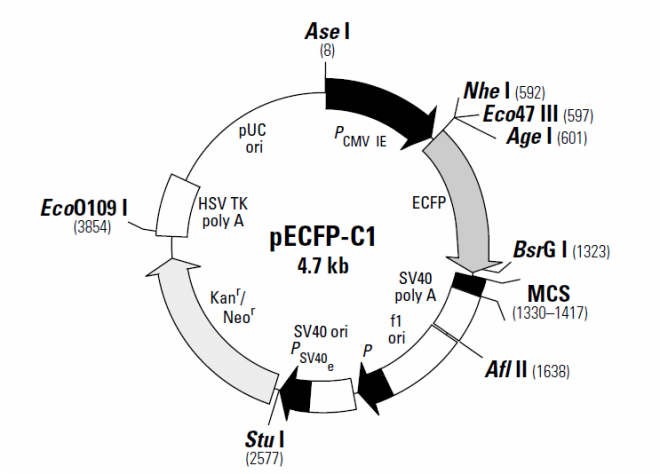
|
品牌 |
酶研生物 | |||||||||||||||||
货号 |
MY1114 | |||||||||||||||||
规格 |
2ug | |||||||||||||||||
价格 |
询价 | |||||||||||||||||
货期 |
现货 | |||||||||||||||||
pECFP-C1 encodes an enhanced cyan fluorescent variant of the Aequorea victoria green fluorescent protein gene (GFP). The ECFP gene contains six amino acid substitutions. The Tyr-66 to Trp substitution gives ECFP fluorescence excitation (major peak at 433 nm and a minor peak at 453 nm) and emission (major peak at 475 nm and a minor peak at 501 nm) similar to other cyan emission variants (1–3). The other five substitutions (Phe-64 to Leu; Ser-65 to Thr; Asn-146 to Ile; Met-153 to Thr; and Val-163 to Ala) enhance the brightness and solubility of the protein, primarily due to improved protein-folding properties and efficiency of chromophore formation (2, 4, 5). In addition to the chromophore mutations, ECFP contains >190 silent mutations that create an open reading frame comprised almost entirely of preferred human codons (6). Furthermore, upstream sequences flanking ECFP have been converted to a Kozak consensus translation initiation site (7). These changes increase the translational efficiency of the ECFP mRNA and consequently the expression of ECFP in mammalian and plant cells. The MCS in pECFP-C1 is between the ECFP coding sequence and the stop codon. Genes cloned into the MCS will be expressed as fusions to the C-terminus of ECFP if they are in the same reading frame as ECFP and there are no intervening in-frame stop codons. ECFP with a C-terminal fusion moiety retains the fluorescent properties of the native protein and thus can be used to localize fusion proteins in vivo. The vector contains an SV40 origin for replication and a neomycin resistance (Neor) gene for selection (using G418) in eukaryotic cells. A bacterial promoter (P) upstream of Neor expresses kanamycin resistance in E. coli. The vector backbone also provides a pUC19 origin of replication for propagation in E. coli and an f1 origin for single-stranded DNA production. The recombinant ECFP vector can be transfected into mammalian cells using any standard transfection method. If required, stable transfectants can be selected using G418 (8). pECFP-C1 can also be used simply to express ECFP in a cell line of interest (e.g., as a transfection marker).
|
|
|||||||||||||||||










